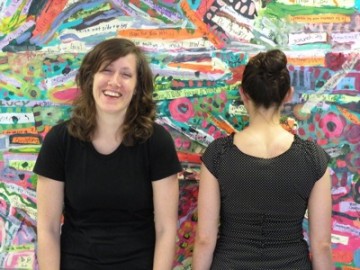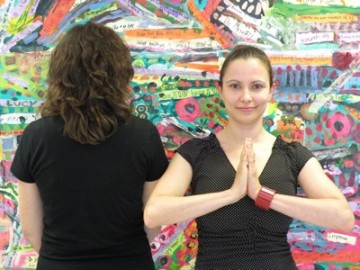Last week we featured Samantha Melvin and Kim Timmons from Burnet, Texas. This week, in the seventh installment of Art21 Educators introductions, allow us to introduce Karen Melvin and Sue Carris, from Pittsburgh, Pennsylvania. Next week’s post will complete our introductions to this year’s cohort of Art21 Educators.
Karen Melvin has been teaching art for twelve years, and has spent ten years in her current position at Thomas Jefferson Middle School, in Pittsburgh PA. Sue Carris has been teaching English at the same school with Karen for the past seven years. Sue describes her working relationship with Karen, “I am lucky to work in a district that supports art education, but even luckier to work with a professional who engages and inspires our students as thinkers and creators.” Looking forward to participating in Art21 Educators with Sue, Karen says, “The multi-disciplinary approach will strengthen [our students’] experiences and their understanding . . . as we collaborate to create lessons that overlap and build sequentially.”
Karen teaches 6-8th grade Visual Art and an 8th grade Art Enrichment elective. Describing how she has used the Art21 films and educational resources to build thematic-based curricula for different student levels Karen says, “Some of the episodes have inspired lessons at their roots and some have served as another perspective on a particular technique or idea to inform and enrich . . . In 6th grade we explore Stories and Play; Identity and Humor in 7th grade; and, Time, Place and Memory in 8th grade. Our year long Art Enrichment elective has time to investigate any number of these themes and more.”
The local art scene also fuels Karen’s teaching practice. Taking her students to exhibitions helps them “grapple with new forms of art.” She elaborates:
Pittsburgh’s own Carnegie International has fueled my interest in introducing contemporary art to my students . . . Contemporary art is reflective of our time and our questions and students are very interested in it once they can grab hold. They begin to take ownership as they see glimpses into their own questions, or brave use of new visual forms.
Within a culture constantly disseminating images and information, all of which we quickly quantify and read at face value, contemporary art requires that we think about things that cannot be seen. Contemporary art operates from multiple perspectives and is not quickly read. It can reveal insights that shape our lives and thoughts as the visual form and intellectual and emotional content meld. I want my students to understand what art and artmaking is about and it matters not if they become artists themselves but that they are participants in the world of ideas.
In her video biography, Karen talks about a few artists that she finds particularly interesting, including her high school art teacher:
One of Karen’s goals for teaching is “to improve the quantity and quality of student dialogue about art.” She is excited to participate in Art21 Educators, and says, “This program is a perfect opportunity to create rich lessons using contemporary art.”
Sue Carris holds a BA in English Literature and Art History, as well as a MA in Teaching from the University of Pittsburgh. She currently teaches 7th grade English, a writing-intensive course, at Thomas Jefferson Middle School. Sue first learned about Art21 films as an Art History student, and later Karen introduced her to Art21 educational resources. Sue states, “After diving into my career in education, my focus drifted away from the art world . . . I am thankful that Karen has rekindled this in me through Art21 Educators.”
As part of her application, we asked Sue to describe her interest in contemporary art as it relates to her teaching practice. Her response reflects her goal to “deeply explore a variety of media in my writing class, cultivating and nurturing the creative spirit and genius of all students, not just those who love writing.” She states:
As a writing teacher, I continually ask my students to explore and express themselves through the written word. However, my students are not only writers, they are creators. The artistic process at the heart of any creative endeavor – be it painting, filmmaking, or writing – is inherently similar. As an educator in this ever-changing world, I don’t just want to help my students improve as writers. I want to help my students express themselves meaningfully across a variety of mediums, to cultivate their creative thinking and imagination, to engage with their peers in true collaboration . . . I want to bring out the contemporary artist in all of them.
Sue also described a teaching unit that incorporated contemporary art and particularly resonated with her students. In support of her school’s anti-bullying program, she wanted to explore the concept of “boundaries” in her classroom, and found inspiration in the photography of David Horvitz. Sue elaborates, “Two of his images capture the borders between California and Mexico and then California and Oregon . . . peaceful beach scenes, a stark contrast in my mind when juxtaposed with the word ‘border.’” The images provided a springboard for classroom discussion. Sue asked her students to consider different definitions or types of borders, from the literal to the abstract. She gave them an assignment to capture an image of particular border and draft a poem that described it. Sue articulates her students’ interest and response to the assignment, “Although a physical description was fine, many students went beyond this, connecting to their emotions, which has been a key component of my writing class.”
Sue shares with us in her video biography her concern for the future of education, and her goal to instill a love for learning in students:
In the coming year, Sue hopes to use technology in her teaching practice and “support digitally literate students, embracing the challenges this presents.” She describes her interest in fostering contemporary skills and says, “I know that Art21 Educators would be the clear link to help me better incorporate digital literacy into my classroom.” Sue elaborates:
The students of today are not the students of five years ago, and these kids interact with their world in more direct and immediate ways, connecting them to a wealth of information, of people, of ideas – all at the tips of their fingers. Simply put, we, as educators, must embrace this change, must cultivate the 21st century skills that our students will need in order to be successful in their future careers . . . I believe that an exploration of contemporary art will help me encourage imaginative thinking, develop creative problem solvers, and inspire a generation of youth who are desperate to create and produce, but who are simply not given the opportunity to do so in their traditional classrooms.
We are excited to meet Karen and Sue this summer in New York City and look forward to hearing more about their goals for teaching and ideas about contemporary art. We welcome them to Art21 Educators!







Pingback: Art21 Educators 2011-2012: Christopher Tourre and Derek De Haan | Art21 Blog